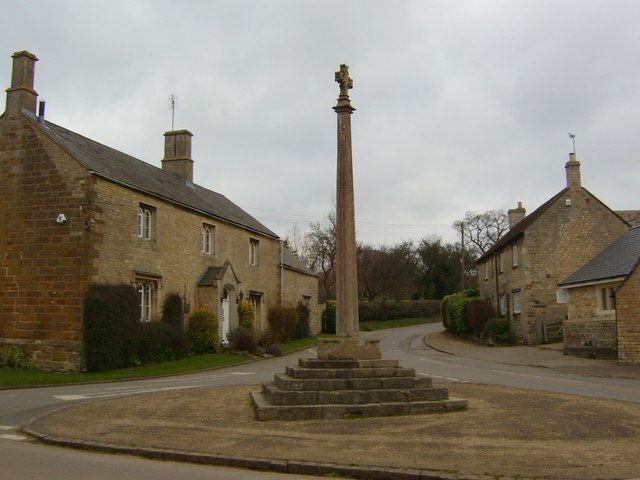Harringworth Cross - geograph.org.uk - 138503.jpg on:
[Wikipedia]
[Google]
[Amazon]
 Harringworth is a village and
Harringworth is a village and
Harringworth Village Website
Villages in Northamptonshire North Northamptonshire Civil parishes in Northamptonshire {{Northamptonshire-geo-stub
 Harringworth is a village and
Harringworth is a village and civil parish
In England, a civil parish is a type of administrative parish used for local government. It is a territorial designation which is the lowest tier of local government below districts and counties, or their combined form, the unitary authorit ...
in North
North is one of the four compass points or cardinal directions. It is the opposite of south and is perpendicular to east and west. ''North'' is a noun, adjective, or adverb indicating direction or geography.
Etymology
The word ''north ...
Northamptonshire
Northamptonshire (; abbreviated Northants.) is a county in the East Midlands of England. In 2015, it had a population of 723,000. The county is administered by
two unitary authorities: North Northamptonshire and West Northamptonshire. It is ...
, England. It is located close to the border with Rutland, on the southern bank of the River Welland
The River Welland is a lowland river in the east of England, some long. It drains part of the Midlands eastwards to The Wash. The river rises in the Hothorpe Hills, at Sibbertoft in Northamptonshire, then flows generally northeast to Market ...
, and around north of Corby
Corby is a town in North Northamptonshire, England, located north-east of Northampton. From 1974 to 2021, the town served as the administrative headquarters of the Borough of Corby. At the 2011 United Kingdom census, 2011 Census, the built-up ...
. At the 2001 Census, the population of the parish was 247, falling to 241 at the 2011 Census.
The area is dominated by the Welland Viaduct
Welland Viaduct, Harringworth Viaduct or Seaton Viaduct, crosses the valley of the River Welland between Harringworth in Northamptonshire and Seaton in Rutland, England.
The viaduct is long and has 82 arches, each with a span. It is the ...
(known locally as the Harringworth Viaduct) that gracefully crosses the Welland and its flood plain immediately to the west of the village.
History
The villages name origin is uncertain. 'Enclosure of the dwellers at the stone(y) place' or 'enclosure at Haering (= stone(y) place)'. Alternatively, the first element may be a personal name, 'Hering/Haerra'. In 1086 Harringworth was considered a large village in thehundred
100 or one hundred (Roman numeral: C) is the natural number following 99 and preceding 101.
In medieval contexts, it may be described as the short hundred or five score in order to differentiate the English and Germanic use of "hundred" to des ...
of Corby, one of many possessions of the Countess Judith
Judith of Lens (born in Normandy between 1054 and 1055, died c1090) was a niece of William the Conqueror. She was a daughter of his sister Adelaide of Normandy, Countess of Aumale and Lambert II, Count of Lens.
Life
In 1070, Judith married Ea ...
. The manor was acquired at some time before 1232 by William I de Cantilupe
William I de Cantilupe (c. 1159 - 7 April 1239) (anciently ''Cantelow, Cantelou, Canteloupe, etc.'', Latinised to ''de Cantilupo'') 1st feudal baron of Eaton (Bray) in Bedfordshire, England, was an Anglo-Norman royal administrator who served ...
(died 1239), 1st feudal baron of Eaton Bray in Bedfordshire, who created a deer park, completed by 1234 when it was stocked with eight does and two bucks sent from Rockingham Forest.
'Harringworth', in An Inventory of the Historical Monuments in the County of Northamptonshire, Volume 6, Architectural Monuments in North Northamptonshire (London, 1984), pp. 80-89. http://www.british-history.ac.uk/rchme/northants/vol6/pp80-89 The last in the male line was Sir George de Cantilupe
George de Cantilupe (1252–1273) (anciently ''Cantelow, Cantelou, Canteloupe, etc'', Latinised to ''de Cantilupo'') The spelling used by modern historians is "de Cantilupe", which is followed in this article was Lord of Abergavenny from the Mar ...
(1251-1273), 4th feudal baron of Eaton, Lord of Abergavenny, one of whose two sisters and co-heiress Millicent de Cantilupe married Eudo de la Zouche, whose descendants were seated at Harringworth and are known as Zouche "of Harringworth", created Baron Zouche in 1308, to distinguish them from the other branch of their family Zouche "of Ashby", created Baron Zouche in 1299. During the medieval period
In the history of Europe, the Middle Ages or medieval period lasted approximately from the late 5th to the late 15th centuries, similar to the post-classical period of global history. It began with the fall of the Western Roman Empire a ...
, Harringworth was associated with the la Zouche family who were Lords of the Manor
Lord of the Manor is a title that, in Anglo-Saxon England, referred to the landholder of a rural estate. The lord enjoyed manorial rights (the rights to establish and occupy a residence, known as the manor house and demesne) as well as seigno ...
and, commencing with William la Zouche, 1st Baron Zouche
William la Zouche, 1st Baron Zouche (1276/86–1352), lord of the manor of Harringworth in Northamptonshire, was an English baron and soldier who fought in the Wars of Scottish Independence. He is referred to in history as "of Harringworth" to ...
, were summoned to Parliament as Barons.
See also
*Harringworth railway station
Harringworth railway station was a railway station near Harringworth, Northamptonshire. It was on the Oakham to Kettering Line of the Midland Railway, at at the south end of Welland Viaduct.
The former signal box which is a listed structur ...
* RAF Spanhoe
Royal Air Force Spanhoe or more simply RAF Spanhoe (also known as Harringworth or Wakerley) is a former Royal Air Force station near Uppingham in Northamptonshire, England. The airfield is located approximately east of Uppingham; about nort ...
References
External links
Harringworth Village Website
Villages in Northamptonshire North Northamptonshire Civil parishes in Northamptonshire {{Northamptonshire-geo-stub